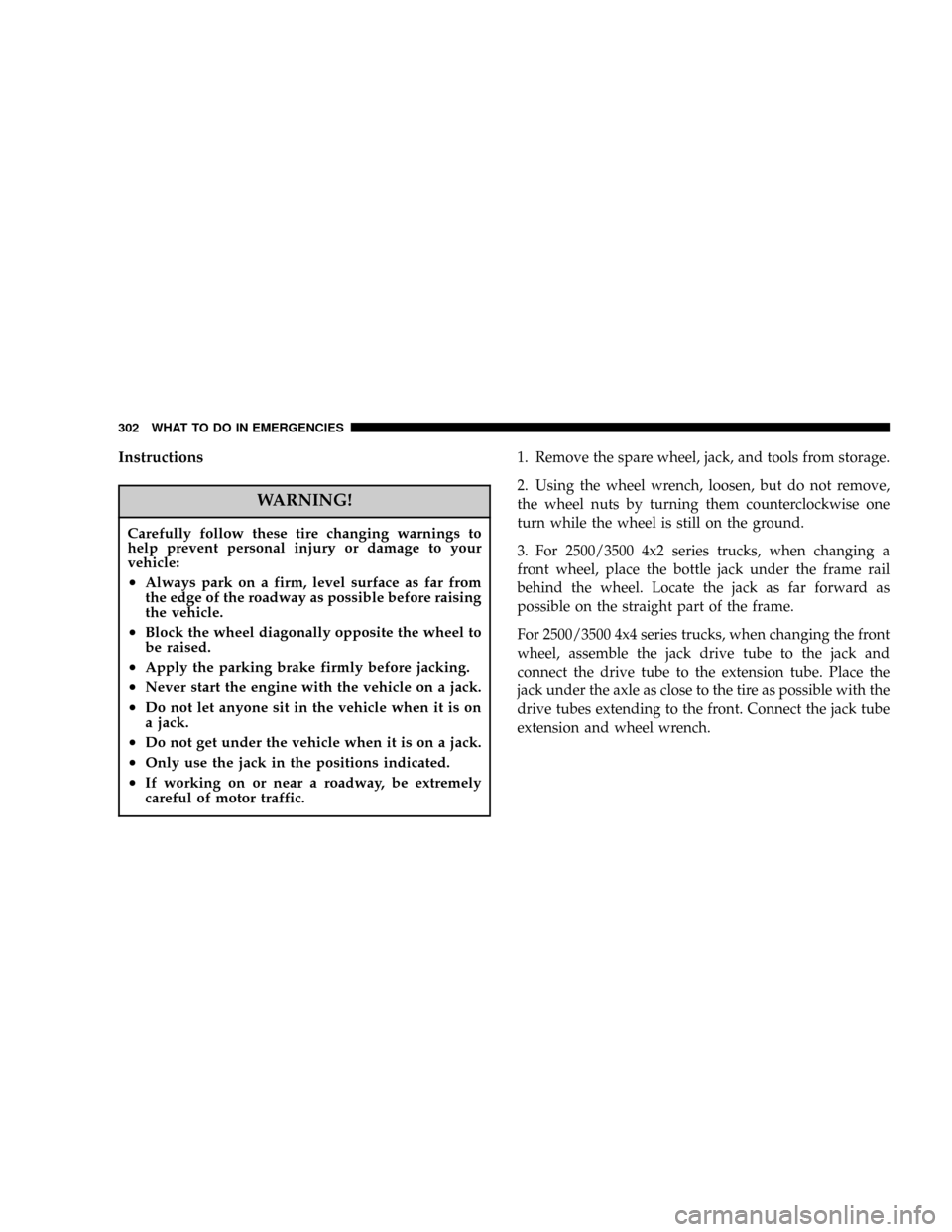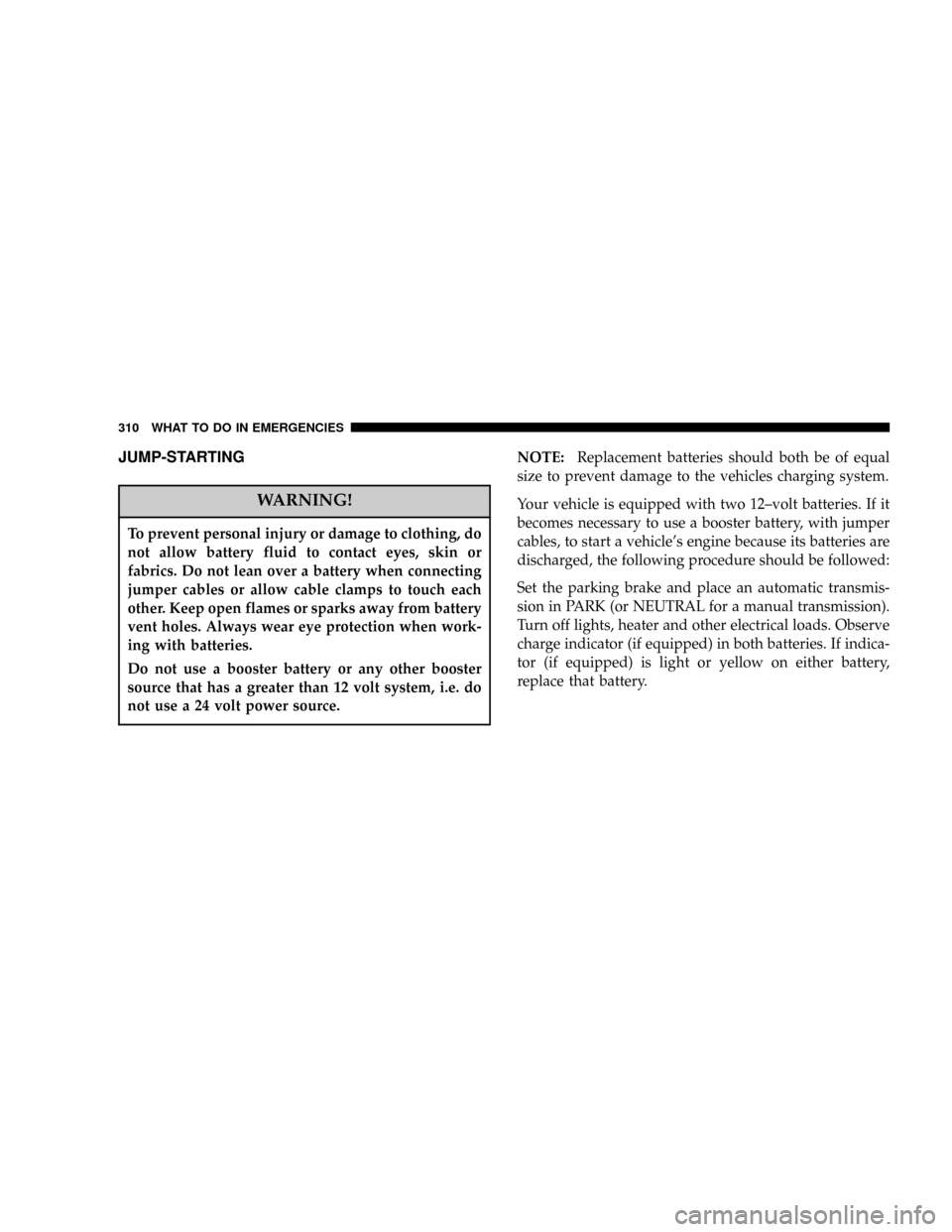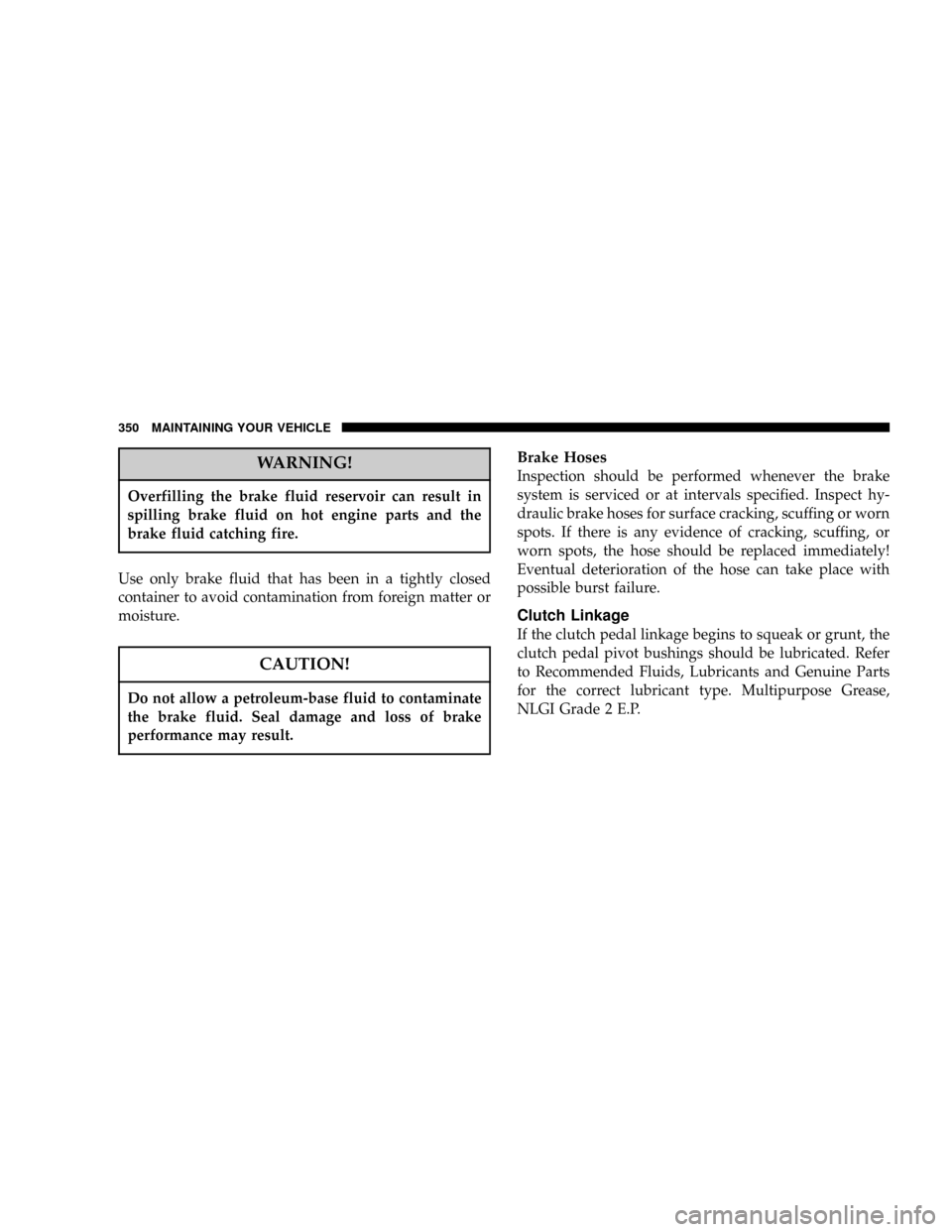Page 302 of 426

Instructions
WARNING!
Carefully follow these tire changing warnings to
help prevent personal injury or damage to your
vehicle:
²Always park on a firm, level surface as far from
the edge of the roadway as possible before raising
the vehicle.
²Block the wheel diagonally opposite the wheel to
be raised.
²Apply the parking brake firmly before jacking.
²Never start the engine with the vehicle on a jack.
²Do not let anyone sit in the vehicle when it is on
a jack.
²Do not get under the vehicle when it is on a jack.
²Only use the jack in the positions indicated.
²If working on or near a roadway, be extremely
careful of motor traffic.
1. Remove the spare wheel, jack, and tools from storage.
2. Using the wheel wrench, loosen, but do not remove,
the wheel nuts by turning them counterclockwise one
turn while the wheel is still on the ground.
3. For 2500/3500 4x2 series trucks, when changing a
front wheel, place the bottle jack under the frame rail
behind the wheel. Locate the jack as far forward as
possible on the straight part of the frame.
For 2500/3500 4x4 series trucks, when changing the front
wheel, assemble the jack drive tube to the jack and
connect the drive tube to the extension tube. Place the
jack under the axle as close to the tire as possible with the
drive tubes extending to the front. Connect the jack tube
extension and wheel wrench.
302 WHAT TO DO IN EMERGENCIES
Page 310 of 426

JUMP-STARTING
WARNING!
To prevent personal injury or damage to clothing, do
not allow battery fluid to contact eyes, skin or
fabrics. Do not lean over a battery when connecting
jumper cables or allow cable clamps to touch each
other. Keep open flames or sparks away from battery
vent holes. Always wear eye protection when work-
ing with batteries.
Do not use a booster battery or any other booster
source that has a greater than 12 volt system, i.e. do
not use a 24 volt power source.
NOTE:Replacement batteries should both be of equal
size to prevent damage to the vehicles charging system.
Your vehicle is equipped with two 12±volt batteries. If it
becomes necessary to use a booster battery, with jumper
cables, to start a vehicle's engine because its batteries are
discharged, the following procedure should be followed:
Set the parking brake and place an automatic transmis-
sion in PARK (or NEUTRAL for a manual transmission).
Turn off lights, heater and other electrical loads. Observe
charge indicator (if equipped) in both batteries. If indica-
tor (if equipped) is light or yellow on either battery,
replace that battery.
310 WHAT TO DO IN EMERGENCIES
Page 318 of 426

NBody Lubrication.....................340
NWindshield Wiper Blades................341
NWindshield Washers...................341
NExhaust System......................342
NCooling System.......................343
NFan ...............................347
NCharge Air Cooler (Inter-Cooler)..........347
NHoses And Vacuum/Vapor Harnesses.......348
NBrake System........................348
NClutch Linkage.......................350
NClutch Hydraulic System................351
NPropeller Shaft Universal Joints...........351NRear Axle And 4X4 Front Driving Axle Fluid
Level..............................351
NTransfer Case Ð If Equipped.............352
NManual Transmission Ð If Equipped.......352
NAutomatic Transmission................353
NFront Wheel Bearings..................355
NSelection Of Lubricating Grease...........356
NNoise Control System Required
Maintenance & Warranty................357
NAppearance Care And Protection From
Corrosion...........................362
mFuse And Relay Center...................366
mVehicle Storage........................366
318 MAINTAINING YOUR VEHICLE
Page 348 of 426

degrees Fahrenheit. This cooling process enables more
efficient burning of fuel resulting in fewer emissions.
To guarantee optimum performance of the system, keep
the surfaces of the charge air cooler, condenser and
radiator clean and free of debris. Periodically check the
hoses leading to and from the charge air cooler for cracks
or loose clamps resulting in loss of pressure and reduced
engine performance.
Hoses And Vacuum/Vapor Harnesses
Inspect surfaces of hoses and nylon tubing for evidence
of heat and mechanical damage. Hard or soft spots,
brittle rubber, cracking, tears, cuts, abrasions, and exces-
sive swelling indicate deterioration of the rubber.
Pay particular attention to those hoses nearest to high
heat sources such as the exhaust manifold. Inspect hose
routing to be sure hoses do not come in contact with any
heat source or moving component which may cause heat
damage or mechanical wear.Insure nylon tubing in these areas has not melted or
collapsed.
Inspect all hose connections such as clamps and cou-
plings to make sure they are secure and no leaks are
present.
Components should be replaced immediately if there is
any evidence of wear or damage that could cause failure.
Brake System
Power Disc Brakes (Front and Rear)
Disc brakes do not require adjustment; however, several
hard stops during the break-in period are recommended
to seat the linings and wear off any foreign material.
Brake Master Cylinder
The fluid level of the master cylinder should be checked
when performing under the hood service, or immedi-
ately if the brake system warning lamp indicates system
failure.
348 MAINTAINING YOUR VEHICLE
Page 349 of 426
The brake master cylinder has a translucent plastic
reservoir. On the outboard side of the reservoir, there is a
ªFULLº dot and an ªADDº dot. The fluid level must be
kept within these two dots. Do not add fluid above the
full mark because leakage may occur at the cap.With disc brakes the fluid level can be expected to fall as
the brake linings wear. However, an unexpected drop in
fluid level may be caused by a leak and a system check
should be conducted.
Refer to Recommended Fluids, Lubricants and Genuine
Parts for the correct Fluid type.
WARNING!
Use of a brake fluid that may have a lower initial
boiling point, or unidentified as to specification,
may result in sudden brake failure during hard
prolonged braking. You could have an accident.
MAINTAINING YOUR VEHICLE 349
7
Page 350 of 426

WARNING!
Overfilling the brake fluid reservoir can result in
spilling brake fluid on hot engine parts and the
brake fluid catching fire.
Use only brake fluid that has been in a tightly closed
container to avoid contamination from foreign matter or
moisture.
CAUTION!
Do not allow a petroleum-base fluid to contaminate
the brake fluid. Seal damage and loss of brake
performance may result.
Brake Hoses
Inspection should be performed whenever the brake
system is serviced or at intervals specified. Inspect hy-
draulic brake hoses for surface cracking, scuffing or worn
spots. If there is any evidence of cracking, scuffing, or
worn spots, the hose should be replaced immediately!
Eventual deterioration of the hose can take place with
possible burst failure.
Clutch Linkage
If the clutch pedal linkage begins to squeak or grunt, the
clutch pedal pivot bushings should be lubricated. Refer
to Recommended Fluids, Lubricants and Genuine Parts
for the correct lubricant type. Multipurpose Grease,
NLGI Grade 2 E.P.
350 MAINTAINING YOUR VEHICLE
Page 353 of 426

Lubricant Selection for NV-5600 (6-Speed Manual
Transmission) Ð If Equipped
This transmission does not require periodic changing. If
it becomes necessary to add fluid or change the fluid, be
sure to use the same lubricant or equivalent. Refer to
Recommended Fluids, Lubricants and Genuine Parts for
the correct lubricant type.
Automatic Transmission
Fluid Level Check
The fluid level should be checked when the engine is
fully warmed up and the fluid in the transmission is at
normal operating temperature. Operation of the trans-
mission with an improper fluid level will greatly reduce
the life of the transmission and of the fluid. Check the
fluid level whenever the vehicle is serviced.
Procedure For Checking Fluid Level
To properly check the automatic transmission fluid level,
the following procedure must be used:
1. The vehicle must be on level ground.
2. The engine should be running at curb idle speed for a
minimum of 60 seconds.
3. Fully apply parking brake.
4. Place the gear selector briefly in each gear position
ending with the lever in N (Neutral).
5. Remove the dipstick and determine if the fluid is hot
or warm. Hot fluid is approximately 180ÉF (82ÉC) which
is the normal operating temperature after the vehicle has
been driven at least 15 miles. The fluid can not be
comfortably held between the finger tips. Warm is when
fluid is between 85É - 125ÉF (29É - 52ÉC).
MAINTAINING YOUR VEHICLE 353
7
Page 356 of 426

²If a bearing assembly is accidentally separated when
servicing the brake rotors, it should be replaced.
Rear Wheel Bearings
Clean and repack when brake linings are replaced or
rotors resurfaced.
Selection Of Lubricating Grease
The National Lubricating Grease Institute (NLGI) has
developed a symbol (Certification Mark) to aid the
vehicle owner in the proper selection of grease for the
lubrication of wheel bearings and chassis components.
This symbol (an example shown below) is located on the
grease container and identifies the application and qual-
ity of the grease.There are two groups
identified: those for wheel
bearings (Letter ªGº) and
those for chassis (Letter
ªLº) lubrication. Perfor-
mance categories within
these groups result in dual
letter designations for
each group. The letter des-
ignations shown in the ex-
ample are the highest
quality level available and when combined as shown can
be used for both wheel bearing and chassis lubrication.
Use only those greases that have the NLGI symbol on the
container along with the proper quality level for your
application.
356 MAINTAINING YOUR VEHICLE